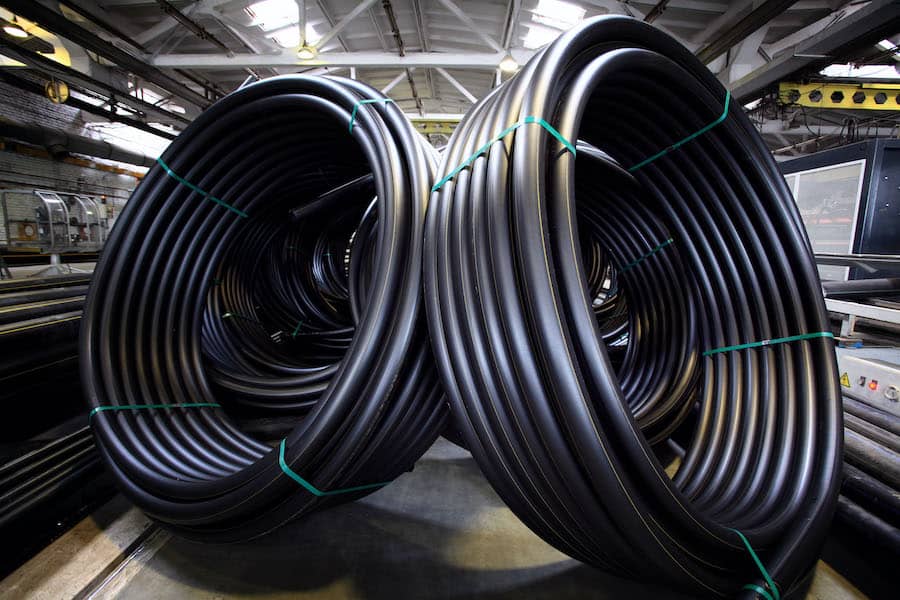LDPE vs HDPE: Properties, Production and Applications
LDPE and HDPE are thermoplastic materials under the family of polyolefins, which are petrochemical-based plastics that include polypropylene (PP) and polyethylene (PE). Polyethylene is the most common plastic material in the world and is known for its simple structure, the simplest of all polymers commercially available.
Collectively under the polyethylene class of materials, LDPE (low-density polyethylene) and HDPE (high-density polyethylene) have shaped the landscape of the packaging and manufacturing industry. LDPE is well known for being widely used in plastic bags as its low density makes it light and flexible, rendering it perfect for this kind of application. HDPE, on the other hand, is harder and offers higher strength and better resistance to heat. Recently, it has become very popular as a source material for 3D printing filaments, used instead of ABS material. It is also used to produce durable plastic parts such as HDPE pipes, toys and plastic chairs.
Although LDPE and HDPE are both thermoplastic ethylene polymers, they differ in several properties and uses. One stark contrast is that LDPE has more branching than HDPE. Branching takes place during polymerisation, where polymer chains have secondary polymer chains attached to them by replacing an atom in the primary chain with a monomer group. This weakens the intermolecular forces in the polymer. That is why HDPE have a higher strength-to-density ratio than LDPE with increased tensile strength.
The varying uses of LDPE and HDPE are based on this fundamental structural difference, among many other properties.
Here, you will learn about:
-
The divergence in properties between LDPE and HDPE
-
The advantages and disadvantages of using each polyethylene material
-
How each of them is produced and processed
-
The different applications of LDPE and HDPE

LDPE plastic bags
Properties of LDPE and HDPE
Although both materials come from the same ethylene monomer, the difference in chemical structure yields a wide variety of unique properties.
As its name suggests, low-density polyethylene (LDPE) has a lower density, strength, and temperature resistance. Meanwhile, high-density polyethylene (HDPE) is characterized by higher specific strength and heat resistance.
Table 1. Comparison of the material properties of LDPE and HDPE
|
Property |
LDPE |
HDPE |
|
Chemical structure |
More branching |
Less branching, more linear |
|
Density |
Low density 0.91-0.94 g/cm3 |
High density 0.95-0.97 g/cm3 |
|
Flexibility |
Low crystallinity (50-60%), and therefore more flexible |
High crystallinity (>90%), which makes it tougher and more rigid |
|
Heat resistance |
Drastic decrease in density when subjected to temperatures beyond 20°C |
Able to withstand heat with temperatures more than 100°C |
|
Melting point |
~115°C |
~135°C |
|
Chemical resistance |
Resistant to most alcohols, acids, and alkalis; low resistance to oxidising agents and selected hydrocarbons |
Superior resistance to solvents, alcohols, acids, and alkalis; low resistance to most hydrocarbons |
|
Strength |
Relatively increased impact strength in cold conditions |
High tensile and specific strength |
|
Transparency |
High, due to amorphous condition |
Low, due to increased level of crystallinity |
|
Maximum allowable stress at 20°C |
6–17 MPa |
14–32 MPa |
Pros and cons of using LDPE and HDPE
While both materials have their respective benefits, they also carry with them a number of disadvantages. Here's a list of the pros and cons of each of LDPE and HDPE.
Table 2. Advantages and disadvantages of using LDPE vs HDPE
|
|
LDPE |
HDPE |
|
Advantages |
Wide variety of uses Low cost Resistant to acids and bases Easy to process and mould Good electrical insulation Waterproof property May be processed as transparent |
Wide variety of uses Low cost High tensile strength Able to resist low temperature Relatively strong and stiff Waterproof property Good electrical insulation |
|
Disadvantages |
More prone to crack stress Not useful in extremely high or low temperatures High permeability to carbon dioxide and other gases Little to no UV resistance |
May crack under stress Higher risk of mould shrinking Little to no UV resistance
|
Production and processing of LDPE and HDPE
How is LDPE produced?
LDPE is made through either a stirred autoclave or tubular reactor. Its general manufacture involves the compression of ethylene gas, polymerisation using an initiator, and gas separation.
How is HDPE produced?
Most HDPE materials are produced by either slurry polymerisation or gas phase polymerisation. The process starts with polymerisation from a solution of ethylene monomers, followed by separation and drying.
How are those two polyethylene materials processed?
Once produced, the thermoplastic material may be processed for consumer or industrial use by the following methods:
Injection moulding
This rapid process converts LDPE and HDPE pellets or granules into custom shapes and sizes defined by the mould. The thermoplastic pellets are sent to a hot barrel, from which the materials are melted through a screw barrel and heater bands. The molten plastic is then injected to a pre-configured mould cavity, which also cools down the material. After solidifying, the plastic material is ejected out of the moulding machine.
Extrusion
Similar to injection moulding, this also makes use of heat to melt the plastic granules. The difference comes at the final section of the machine – in this case, the melted plastic goes through a pre-designed opening and is then cooled down to solidify.
Blow moulding
This type of processing is usually carried out to manufacture hollow-shaped plastic goods. Instead of injecting the molten plastic, the process uses compressed air to blow the material into the mould.

HDPE pipes
Applications of LDPE and HDPE
LDPE applications include:
- LDPE plastic bags
- Light packaging materials: Six-pack rings, waterproof carton lining, plastic wraps, snap-on lids
- Wash bottles
- Corrosion protection layer for work surfaces
- Computer hardware covers and packaging
HDPE applications include:
- HDPE filament for 3D printers
- Strong packaging materials: bottle caps, plastic milk bottles, drums, bulk containers for industrial use
- Fibres for ropes, nets, and industrial fabrics
- Vehicle fuel tanks
- Boat parts
- HDPE pipes and tubing
- HDPE plastic chairs and tables
- Playground structures: slides, swing seats
- Consumer products: trash and recycling bins, ice cube containers, toys, ice chests
If you've enjoyed reading this article, you can also read more related content here:
Sources
[1] S.T. Sam, M.A. Nuradibah, H. Ismail, N.Z. Noriman, S. Ragunathan, "Recent Advances in Polyolefins/Natural Polymer Blends Used for Packaging Application", Polymer-Plastics Technology and Engineering, 53:6, pp. 631-44, 2014.
[2] A. Peacock, Handbook of Polyethylene: Structures, Properties, and Applications, NY: Marcel Dekker, Inc., 2000.
[3] NIIR Board of Consultants and Engineers, The Complete Technology Book on Plastic Films, HDPE and Thermoset Plastics, India: Asia Pacific Business Press, Inc., 2006.
[4] "Highlights of Low-Density Polyethylene", [Online] Available from: https://www.plasticsmakeitpossible.com/about-plastics/faqs/professor-plastics/professor-plastics-highlights-of-low-density-polyethylene/
[5] Yashoda, "Difference Between HDPE and LDPE", [Online] Available from: http://pediaa.com/difference-between-hdpe-and-ldpe/, 2016.
[6] J.P. Plog, "Processing Polyethylene", [Online] Available from: https://www.thermofisher.com/blog/materials/processing-polyethylene/, 2015.
